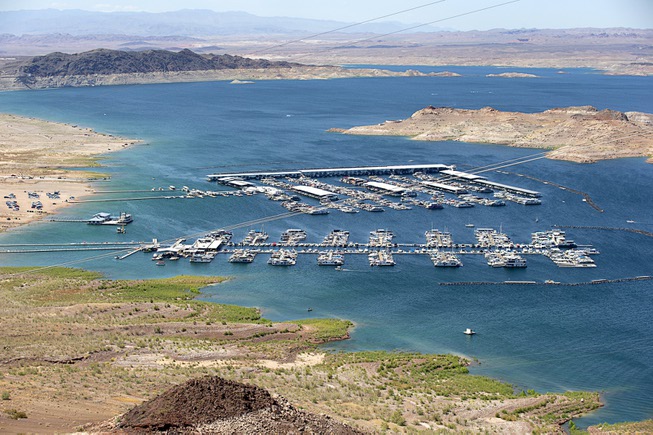
A view of the Lake Mead Marina and Las Vegas Boar Harbor from the Lakeview Overlook at Lake Mead Friday, May 26, 2023.
Published Wednesday, Oct. 25, 2023 | 2:02 p.m.
Updated Wednesday, Oct. 25, 2023 | 5:26 p.m.
A record-breaking winter snowpack this year and the Lower Colorado River Basin states’ recent agreement to cut water use should be enough to protect Lake Mead and Lake Powell from dropping to dangerously low levels for the next three years, according to the U.S. Bureau of Reclamation.
The federal government released the new draft Supplemental Environmental Impact Statement on Wednesday. It will remain in effect through 2026, when the current guidelines governing Colorado River usage will expire. Reclamation Commissioner Camille Calimlim Touton said the 3 million-acre-foot reduction that California, Arizona and Nevada agreed to reach by the end of 2026 was enough to guarantee short-term sustainability for the Colorado and its tributaries, which supply water to 40 million people across seven Western states, 30 Tribal nations and part of Mexico..
“The Colorado River Basin’s reservoirs, including its two largest storage reservoirs Lake Powell and Lake Mead, remain at historically low levels,” she said. “Today’s advancement protects the system in the near-term while we continue to develop long-term, sustainable plans to combat the climate-driven realities facing the Basin.”
The new draft SEIS includes new models based on hydrology data from June, which showed significant improvements over the September 2022 data the Bureau of Reclamation used for the initial draft SEIS. According to the bureau, the risk of reaching critical elevations has been reduced to 8% at Lake Powell and 4% at Lake Mead. An Oct. 22 report from the Bureau of Reclamation showed Lake Powell at 37% of capacity and Lake Mead at 34%.
“Throughout the past year, our partners in the seven Basin states have demonstrated leadership and unity of purpose in helping achieve the substantial water conservation necessary to sustain the Colorado River system through 2026,” Deputy Secretary Tommy Beaudreau said.
In April, the Bureau of Reclamation released a plan that considered two methods of reducing the water supply for Arizona, Nevada and California. One would have used a decades-old water priority system. The other would have been an equal percentage cut for all three states. The Lower Basin states avoided both fates by reaching the 3 million-acre-foot agreement.
The abnormally wet winter of 2022-23 was a lucky break, but it’s a drop in the bucket compared to the 22-year streak of high temperatures and drought that has consumed most of the West and continuously depleted the Colorado River.
A study by UCLA’s department of atmospheric and oceanic sciences released in July found the river system has lost 10 trillion gallons of water in the last 20 years. Runoff has fallen by 10.3% since 1880.
“We demonstrate that Colorado Basin’s natural flow has been decreased by roughly the storage of Lake Mead during the 2000–2021 megadrought due to this long term anthropogenic influence, suggesting the basin’s first shortage in 2021 would likely not have occurred without anthropogenic warming,” the study states.
“It’s important for the public to realize that we are facing a much larger crisis that wasn’t analyzed at all in this document,” said Kyle Roerink, executive director of the Great Basin Water Network, which works to promote water conservation efforts in the Great Basin states of California, Idaho, Nevada, Oregon, Utah and Wyoming. “We were saved by a wet winter.”
Roerink said the Bureau of Reclamation and Basin states were “patting themselves on the back,” for the results of the new draft SEIS, but the Colorado River Basin and those who depend on it still face rising temperatures and aridification due to climate change.
“Would they be able to do this 10 years in a row, through drought and the tightening grip of aridification?” he asked.
Roerink said his attention was focused squarely on negotiations for the new 2027 guidelines, and Wednesday’s announcement could serve as a distraction from the bigger picture.
“Folks were ready to sue each other over the original draconian SEIS cuts,” Roerink said. “The schedule of how those would be implemented was predicated on the federal government’s understanding of priority duties for water users.”
He said the lower Basin states’ 3 million-acre-foot agreement was a last-ditch effort to avoid those cuts and the legal battles that would have followed.
“It’s a lot easier to live with any cuts when Mother Nature is giving you what you want,” he said.
The new draft SEIS will be published Friday in the Federal Register, which will trigger a 45-day public comment period. The federal government is currently developing replacement guidelines that will go into effect in 2027, replacing the current drought guidelines for the Colorado River Basin developed in 2007.
This month, the Bureau of Reclamation released a scoping report for post-2026 Colorado River operations and announced plans to invest $8.3 billion in Bipartisan Infrastructure Law funding into water projects over the next five years. An additional $4.6 billion in Inflation Reduction Acts funds will go to water conservation efforts in the Colorado River Basin.
The first draft of the post-2026 plan is slated for completion at the end of 2024, and a final draft will be available the following year, according to the Bureau of Reclamation.
[email protected] / 702-948-7836 / @Missmusetta
